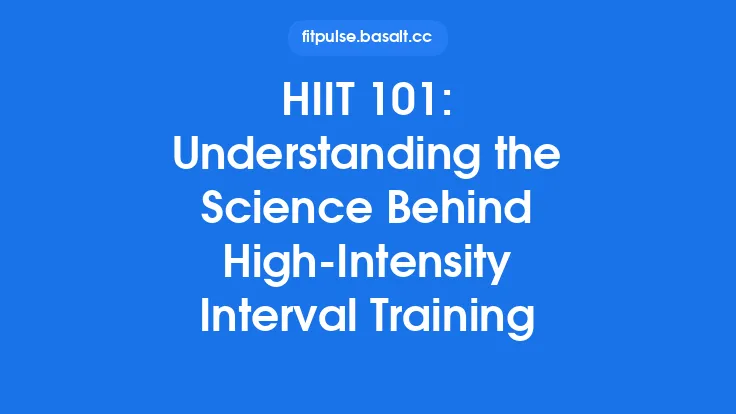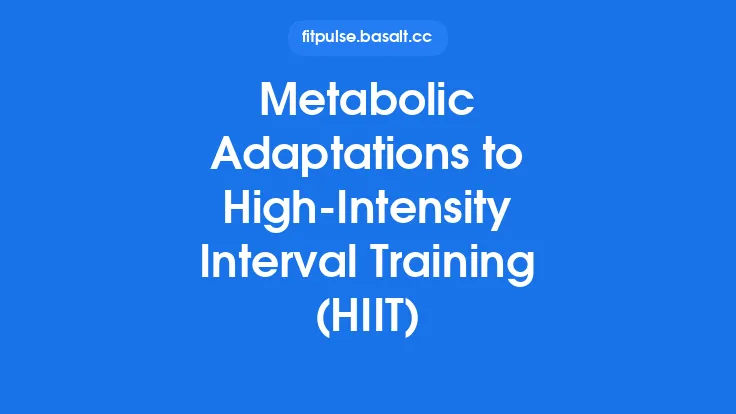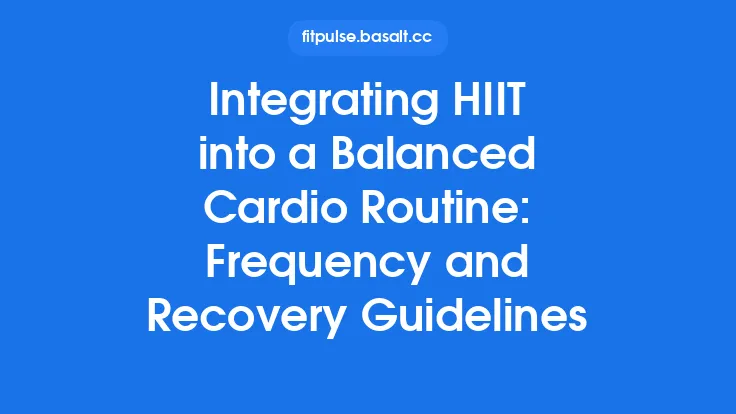High‑Intensity Interval Training (HIIT) has become one of the most researched and widely adopted training modalities in modern exercise science. Its appeal lies in the ability to achieve substantial physiological adaptations in a relatively short amount of time, making it especially attractive for individuals with busy schedules or those seeking efficient pathways to improve cardiovascular health, metabolic function, and overall fitness. This article delves into the underlying mechanisms, evidence‑based protocols, practical programming considerations, and safety guidelines that together form a comprehensive, evergreen resource for anyone interested in mastering HIIT.
Understanding the Physiology of HIIT
Energy System Contributions
HIIT sessions typically consist of brief bouts (10 seconds to 4 minutes) of near‑maximal effort interspersed with recovery periods. The primary energy systems engaged are:
| Phase | Dominant System | Primary Substrate | Typical Duration |
|---|---|---|---|
| Work Interval | Phosphagen (ATP‑CP) → Anaerobic Glycolysis | Creatine phosphate, muscle glycogen | ≤ 30 s (phosphagen) → 30 s–2 min (glycolysis) |
| Recovery | Oxidative (Aerobic) | Fatty acids, glucose | 30 s–4 min (depends on work‑to‑rest ratio) |
During the high‑intensity effort, the phosphagen system supplies immediate ATP, but its capacity is exhausted within ~10 seconds. As the interval extends, anaerobic glycolysis takes over, producing lactate and hydrogen ions. The subsequent recovery period allows the aerobic system to replenish phosphocreatine stores, clear lactate, and restore homeostasis. Repeated cycles create a cumulative metabolic stress that drives adaptations far beyond what steady‑state cardio can achieve in the same total time.
Mitochondrial Biogenesis
Repeated HIIT bouts stimulate the activation of AMP‑activated protein kinase (AMPK) and the transcriptional co‑activator PGC‑1α, both pivotal regulators of mitochondrial biogenesis. This leads to increased oxidative capacity, improved substrate utilization, and enhanced endurance performance even after relatively few training sessions.
Hormonal and Molecular Responses
Acute HIIT triggers spikes in catecholamines (epinephrine, norepinephrine), growth hormone, and testosterone, which together promote lipolysis, protein synthesis, and glycogen replenishment. Chronic exposure results in improved insulin sensitivity, reduced resting blood pressure, and favorable lipid profile shifts.
Core HIIT Protocol Structures
While countless variations exist, most evidence‑based HIIT programs can be categorized into three foundational structures:
- Short‑Interval HIIT (SI‑HIIT)
- Work: 10–30 seconds at 85–100 % of maximal aerobic speed (MAS) or 90–100 % of maximal heart rate (HRmax).
- Rest: 30 seconds to 2 minutes of active or passive recovery.
- Typical Set: 8–12 repetitions, total session ≤ 20 minutes.
- Use Cases: Enhancing anaerobic power, improving sprint capacity, and boosting VO₂max in well‑trained athletes.
- Long‑Interval HIIT (LI‑HIIT)
- Work: 2–4 minutes at 80–90 % MAS or 85–95 % HRmax.
- Rest: Equal or slightly longer active recovery (2–5 minutes).
- Typical Set: 4–6 repetitions, total session 25–35 minutes.
- Use Cases: Targeting aerobic endurance, increasing lactate threshold, and supporting weight‑loss programs.
- Mixed‑Interval HIIT (MI‑HIIT)
- Work: Alternating short and long intervals within the same session (e.g., 30 seconds followed by 2 minutes).
- Rest: Proportionate to each work interval, often 1:1 or 1:2 work‑to‑rest ratio.
- Typical Set: 10–15 total intervals, total session 20–30 minutes.
- Use Cases: Providing a balanced stimulus for both aerobic and anaerobic systems, ideal for general fitness and time‑efficient conditioning.
Designing a HIIT Session: Variables and Progression
| Variable | Definition | Practical Range | Progression Strategy |
|---|---|---|---|
| Intensity | % of MAS, HRmax, or perceived exertion (RPE 8–10) | 85–100 % MAS / 90–100 % HRmax | Increase %MAS, add resistance, or reduce rest |
| Duration of Work | Length of each high‑intensity bout | 10 s–4 min | Extend interval length or add repetitions |
| Rest Interval | Recovery period between work bouts | 30 s–5 min (active/passive) | Shorten rest, switch to active recovery |
| Number of Repetitions | Total intervals per session | 4–12 (depending on interval length) | Add sets or increase repetitions |
| Frequency | Sessions per week | 2–4 (depending on fitness level) | Add an extra day, or combine with lower‑intensity cardio |
Progression Example (Beginner to Intermediate)
- Week 1–2: 6 × 30 s work at 85 % MAS, 90 s active recovery (total 20 min).
- Week 3–4: 8 × 30 s work at 90 % MAS, 60 s active recovery.
- Week 5–6: 6 × 1 min work at 90 % MAS, 60 s active recovery.
- Week 7–8: 4 × 2 min work at 85 % MAS, 2 min active recovery.
Progression should be guided by the “two‑for‑one” rule: for every two weeks of consistent training, increase one variable (intensity, duration, or volume) while maintaining the others.
Equipment and Modality Options
HIIT is inherently versatile. The choice of equipment influences the specific muscular demands but does not alter the core interval principle.
| Modality | Typical Workload | Primary Muscles Engaged | Example Protocol |
|---|---|---|---|
| Bodyweight | Push‑ups, burpees, jump squats | Full‑body (pectorals, quads, glutes) | 20 s work / 10 s rest × 8 rounds |
| Stationary Bike | 90–100 % of peak power output | Quadriceps, glutes | 30 s sprint / 60 s easy pedaling × 10 |
| Treadmill | 12–15 km/h (incline optional) | Lower‑body, core | 1 min run / 2 min walk × 6 |
| Rowing Machine | 90 % of 2‑minute max row | Back, legs, core | 500 m row / 2 min rest × 5 |
| Kettlebell | Swings, snatches at moderate load | Posterior chain | 45 s swings / 15 s rest × 10 |
| Battle Ropes | High‑intensity waves | Upper back, shoulders | 20 s waves / 40 s rest × 12 |
When selecting a modality, consider the athlete’s skill level, joint health, and training goals. For beginners, low‑impact options (e.g., stationary bike or rowing) reduce injury risk while still delivering metabolic stimulus.
Performance and Health Benefits
- Cardiovascular Improvements
- ↑ VO₂max (average 5–15 % after 6–8 weeks).
- ↓ Resting heart rate and systolic blood pressure.
- Metabolic Enhancements
- ↑ Insulin sensitivity (up to 30 % improvement).
- ↑ Post‑exercise oxygen consumption (EPOC) leading to higher caloric burn for up to 48 hours.
- Body Composition
- Favorable shift toward higher lean mass and reduced visceral fat, especially when combined with adequate protein intake.
- Neuromuscular Adaptations
- ↑ Motor unit recruitment and firing frequency, translating to better sprint performance and agility.
- Psychological Effects
- ↑ Endorphin release and perceived self‑efficacy; many report higher enjoyment compared with longer steady‑state cardio.
- Time Efficiency
- Comparable or superior adaptations to traditional endurance training in ≤ 30 minutes per session.
Safety Considerations and Contraindications
| Issue | Risk | Mitigation |
|---|---|---|
| Cardiovascular Events | Sudden cardiac arrest in high‑risk individuals | Pre‑participation screening (e.g., PAR‑Q, ECG for at‑risk groups) |
| Musculoskeletal Overload | Tendonitis, joint strain from high forces | Emphasize proper technique, incorporate low‑impact modalities, allow adequate recovery |
| Excessive Fatigue | Overtraining, hormonal imbalance | Follow progressive overload guidelines, schedule at least 48 h between intense HIIT sessions for beginners |
| Heat‑Related Illness | Dehydration, heat exhaustion | Hydrate, avoid extreme ambient temperatures, adjust intensity accordingly |
| Pregnancy | Potential fetal stress | Consult obstetric provider; modify to low‑impact, lower‑intensity intervals if cleared |
General Safety Checklist
- Warm‑up 5–10 minutes (dynamic mobility, low‑intensity cardio).
- Verify equipment stability and proper setup.
- Use a heart‑rate monitor or RPE scale to stay within target intensity.
- Cool‑down 5 minutes of light activity and static stretching.
- Record session data (interval times, HR, perceived exertion) for progressive tracking.
Monitoring and Adjusting Intensity
- Heart‑Rate Zones: Use a chest strap or optical monitor to keep work intervals within 85–95 % HRmax.
- Power Output: On cycle ergometers or rowing machines, track watts; aim for 90–100 % of the individual’s 4‑minute maximal power.
- Rate of Perceived Exertion (RPE): Scale of 1–10; target 8–9 during work, 3–4 during recovery.
- Lactate Testing (optional): For elite athletes, measuring blood lactate after a set can fine‑tune interval length and rest.
If HR or RPE consistently exceeds the prescribed range, reduce work duration or increase rest. Conversely, if values fall below target, increase intensity or shorten recovery.
Integrating HIIT into a Balanced Training Program
- Periodization
- Macrocycle: Allocate 2–3 HIIT blocks per year, each lasting 4–6 weeks, interspersed with lower‑intensity endurance or strength phases.
- Microcycle: Example week – Mon: HIIT, Tue: Strength, Wed: Active recovery, Thu: HIIT, Fri: Mobility/Strength, Sat: Light steady‑state cardio, Sun: Rest.
- Complementary Strength Work
- Pair HIIT with full‑body resistance sessions 2–3 times per week to preserve muscle mass and improve joint stability.
- Recovery Strategies
- Prioritize sleep (7–9 h), nutrition (protein 1.6–2.2 g/kg body weight), and active recovery modalities (foam rolling, low‑intensity swimming).
- Special Populations
- Older Adults: Use shorter work intervals (15–30 s) at moderate intensity (70–80 % HRmax) with longer active recovery.
- Athletes in Skill‑Dominant Sports: Incorporate sport‑specific movements (e.g., shuttle runs, plyometric drills) within the HIIT framework while respecting the neighboring article’s scope on plyometrics.
Common Misconceptions and FAQs
Q1: “HIIT is only for elite athletes.”
Fact: Research shows beginners can achieve significant health benefits after just 2–3 sessions per week, provided the intensity is appropriately scaled.
Q2: “More is always better—do as many intervals as possible.”
Fact: Excessive volume raises injury risk and can blunt hormonal responses. Quality of effort outweighs sheer quantity.
Q3: “I need fancy equipment to do HIIT.”
Fact: Bodyweight circuits, stair climbs, or simple jump rope intervals are fully effective when structured correctly.
Q4: “HIIT will make me lose muscle.”
Fact: When combined with adequate protein intake and resistance training, HIIT preserves or even augments lean mass due to its anabolic hormonal spikes.
Q5: “I can do HIIT every day.”
Fact: Muscular and cardiovascular systems require recovery. For most individuals, 2–3 sessions per week are optimal; daily HIIT is reserved for highly trained athletes with robust recovery protocols.
By understanding the scientific foundations, mastering the core protocol structures, and adhering to evidence‑based safety guidelines, practitioners can harness HIIT as a powerful, time‑efficient tool for improving cardiovascular fitness, metabolic health, and overall performance. The flexibility of HIIT allows it to be tailored to a wide range of populations—from sedentary beginners to seasoned competitors—making it a cornerstone methodology within the broader field of exercise science.





